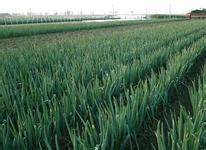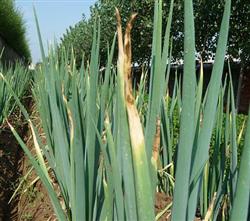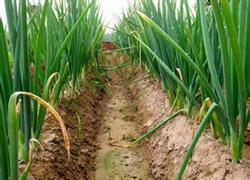Pollution-free Control techniques of insect pests in Welsh Onion Field

First, onion thrips, also known as small white insects, tobacco thrips. Adults and nymphs suck the sap in the leaves with file-sucking mouthparts, which make the onion leaves form many fine long yellow and white spots. In severe cases, the leaves turn yellow and white, twist, wither and droop, which seriously affects the yield and quality of green onions. 1. Occurrence regularity. Spring onion thrips can occur all year round, with 3-10 generations a year. Overwintering with adults or nymphs (mainly adults) in the leaf sheaths of Welsh onions and in soil crevices and fallen leaves, or among weed plants and in onion fields covered with grass and dung. The suitable environment for harm to onions is: temperature 23-28 ℃, relative humidity 40-70%. More than 38 ℃ nymphs died one after another, and the damage was alleviated under the condition of high temperature and humidity. Spring onion thrips generally begin to breed and harm in spring, and the damage is the most serious from late May to early June, with more rainfall and less harm after July. The adults of thrips are afraid of light, which is mainly harmful at night and generally in the backlight during the day. 2. Control measures ⑴ removes the overwintering sites of onion thrips and reduces the source of overwintering insects. When preparing the soil before planting, remove the weeds in the field and the remnants and dead leaves of the previous crops in time, and concentrate on burying or burning them, so as to reduce the overwintering places of thrips. Weeding, ploughing, and reducing the habitat and breeding sites of thrips during the growth of green onions. ⑵ changed the field environmental conditions and inhibited the occurrence of insect pests. In the early spring drought, timely irrigation and frequent watering with small water can increase the humidity in the field and restrain the harm of spring onion thrips. ⑶ traps and kills adults and reduces the population density. Use the white oil board to trap and kill the onion thrips. The method is to use white cardboard, put on a plastic film bag, apply medical oil on both sides (add a little zinc and parathion to the oil), and determine the position of the prepared white board at a height of 50 cm from the ground with a distance of 7 meters. fix the white board facing southwest during the morning-12:00 period on a sunny day. It has a good trapping effect. Chemical control of ⑷. 50% dimethoate emulsion, 50% malathion, 50% Batan wettable powder 1000 times solution, 25% killing EC 6000 times solution can be used alternately. Each agent can only be sprayed once in one growing season of Welsh onion. And stop taking medicine 10-15 days before collection. In order to reduce the pesticide residues in the green onion products and make the product quality up to the standard. Second, Liriomyza huidobrensis, also known as leaf miner, leaf maggot. The larvae zigzag through the leaves all their lives, feeding on the mesophyll, and a tortuous serpentine tunnel can be seen on the leaf. after the mesophyll is eaten, only two layers of white and transparent leaf epidermis are left. in serious cases, one leaf is damaged by multiple insects, and the mesophyll is eaten in large quantities, which seriously affects the photosynthesis. 1. Occurrence regularity. There are 3-5 generations a year, and the pupa overwinters in the leaves of the killed Welsh onion and in the soil. In the first ten days of May, the adults laid their eggs in the leaf tissue of Welsh onion in the evening, and the eggs were white. The larvae hatched 4-5 days later, that is, they began to feed in the leaves. June was the peak period of the damage. The mature larvae pupated at one end of the tunnel and began to Eclosion through the broken leaf epidermis after pupation. Because the onion leaf miner larvae have been endangering in the leaves, the air humidity has little effect on its growth and development, but the temperature has a great influence, and the damage is mild in hot weather. ⑴ cleans the countryside and eliminates the source of insects. Before planting and after harvest, the residual and dead leaves in the field should be removed in time, burned and buried out of the field, and turned deeply and irrigated in winter to eliminate the source of overwintering insects. ⑵ traps and kills adults. Can use brown sugar, vinegar 100g each, add water 1000 g boil, add 40 g trichlorfon, adjust to even, and then evenly mix on 40 kg of hay and leaves, sprinkle into the field to kill adults. ⑶ chemical control. The best spraying effect should be grasped during the peak spawning period of adults or the early hatching stage of larvae to kill adults and eggs. Insecticide and ovicidal agents were sprayed once a week since early May. Tobacco lime water can also be used to kill eggs. Production method: 0.5 kg of tobacco leaves, soak in 20 kg water for one day and night, then filter out tobacco leaves and tobacco dregs; then use 10 kg water to turn 0.25 kg of raw lime into lime milk, and then filter. Before use, mix tobacco water and lime milk evenly, then you can use it. During the peak period of adult occurrence, 40% dimethoate EC 1000-1500 times, 50% trichlorfon 800 times, 25% killing EC 6000 times were used alternately and sprayed alternately. Each agent can only be sprayed once in one growing season of Welsh onion. And stop taking medicine 10-15 days before collection. Third, sowing flies in onion fields. 1. Occurrence regularity. There are three generations a year, overwintering as pupae or larvae. The damage period of the first generation larvae is in the middle of May, the second generation larvae is in the middle of June, and the third generation larvae is in the middle of October. Adults are the most active at noon and concentrate on spring onions and garlic fields to lay eggs. The egg period is generally 6 days, and the larval stage is 17-20 days. The mature larvae pupate in the soil to survive the winter. 2. Control technology ⑴ fertilization to drive flies. Onion flies are saprophytic, and farm fertilizers such as manure and cake fertilizers applied to the field must be fully mature to reduce the accumulation of pests. More application of river mud, Kang soil and old house soil as base fertilizer, river mud, Kang soil and old house soil have the smell that onion flies do not like, and have the ability to drive flies. ⑵ killed overwintering larvae and pupae. The winter idle plots of cultivated spring onions were turned deeply at the end of autumn to kill some overwintering larvae and pupae. In addition, winter irrigation can also effectively kill some overwintering pupae. ⑶ used sugar and vinegar solution to trap and kill adults. With 0.5 kg brown sugar, 0.25 kg vinegar, 0.05 kg wine, 0.5 kg water and a little trichlorfon, pour the prepared sugar and vinegar into a basin, keep it 5 cm deep and put it into the field. ⑷ chemical control. During the peak period of adults, 21% EC was sprayed 3000-4000 times at noon, 2.5% deltamethrin EC was 3000 times, and each agent was sprayed once in 1 growing season of Welsh onion and stopped 10-15 days before harvest. In the planting of onion seedlings, 500 times of 75% phoxim EC was dipped in the root to prevent and control larval damage.
- Prev

Fertilization techniques for High quality and High yield of Welsh Onion
The cause of root rot of Welsh onion is similar to that of retting root, and it is a fungal disease. It is a disease caused by Pythium, Fusarium oxysporum, Phytophthora and other pathogens. The pathogen overwintered in the soil or on the diseased body and became the main source of primary infection the following year. The pathogen invaded from the rhizome or root wound and entered through Rain Water or irrigation water.
- Next

Winter management of wheat field interplanted with scallions
When the weather turns cool in early autumn, onions begin to grow vigorously, but the temperature is still high and the plant grows slowly. the requirement for moisture is not high, so we should water less. Watering should be carried out in the morning and evening, avoid watering at noon to suddenly reduce the ground temperature, affecting root growth. In late August, when the average temperature in North China is below 24 ℃, green onions.
Related
- Where is it suitable to grow horseradish in China? it is expected to see the middle altitude horseradish in Alishan.
- How to prevent tomato virus disease reasonably? (Control methods included)
- Many people like to plant towel gourd on the balcony. What are the main points of this method and management?
- What crops can chili peppers be mixed with?
- Fertilization techniques and matters needing attention in Tomato
- What are the grafting techniques for peach seedlings in spring?
- Harm and control methods of root swelling disease of Chinese cabbage
- What are the pests of sweet potatoes? How to prevent and cure it?
- Symptoms, causes and Control methods of navel Rot in Tomato
- The cause of "Cucumber rotten bibcock" in Farmers' planting Cucumber and its Control Plan

